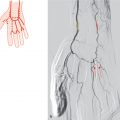41 Vertebral Artery
F. Goetz, A. Giesemann
41.1 Origin
Although the number of anomalies on the right and left side seem to be comparable on the whole, there are major differences between sides within the different types. The left side shows a tendency to a more medial origin, the right side to a more lateral origin.1–10

Fig. 41.1 Origin from the subclavian artery on the top of the arch, near the thyrocervical trunk (right side 90%; left side 90%). Schematic.

Fig. 41.2 Origin from the subclavian artery further medial, more than 2 cm from the thyrocervical trunk; on the right side, often from the bifurcation of the brachiocephalic trunk (right side 4%; left side 3%). Schematic.

Fig. 41.3 Origin from the subclavian artery lateral to the thyrocervical trunk (right side 4%; left side <0.1%). Schematic.

Fig. 41.4 Common origin with the thyrocervical trunk (right side <1%; left side 2%). Schematic.

Fig. 41.5 Origin from the aortic arch (right side <0.1%; left side 4%). For different subtypes, see Figs.2.12–2.19. Schematic (a) and X-ray angiography, anterior view, left subclavian artery injection (b); because the catheter slipped out of the subclavian artery, the second frame looks like an aortic arch injection; finally the tip of the catheter is inside the origin of the left vertebral artery, which originates directly from the aortic arch.
Stay updated, free articles. Join our Telegram channel

Full access? Get Clinical Tree








